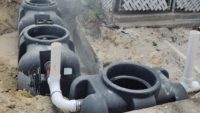In an era when plumbing systems are continuing to advance from metal to plastics, contractors are speculating which plastic piping system is best. The right answer can be found by learning some technical facts about crosslinked polyethylene (PEX) pipe — a flexible, durable, plastic piping material that has been used for decades in plumbing and heating applications worldwide.
While all PEX pipe must adhere to specific standards for temperature and pressure ratings and pipe-wall thickness, many variables in the manufacturing methods of PEX affect pipe performance. This article will address four technical attributes of PEX to guide you in choosing the best plumbing system for a structure.
No. 1: Uniform crosslinking for the greatest durability
Crosslinking of a polymer results in a network of molecules that are chemically bonded together, rather than solely maintaining individual polymer molecules. By crosslinking high-density polyethylene (HDPE) to get PEX, this process improves the pipe’s ability to maintain pressure holding capabilities at elevated temperatures. It also provides several other mechanical properties.
Polyethylene is comprised of a backbone of carbon atoms with attached hydrogen atoms. During the crosslinking process, the carbon atoms in the individual HDPE molecule bond to the carbon atoms in other HDPE molecules. As a result, the carbon chains are bonded together to form a strong network.
Currently, there are three methods to produce PEX, called PEX-a, PEX-b and PEX-c. With the Engel-method PEX-a manufacturing process, there are no “interference” atoms between the HDPE molecules. Hence, this achieves a direct carbon-to-carbon bonding and the highest degree of crosslinking (around 85%) for the most flexible and durable PEX piping product.
The high-temperature, hot-extrusion, single-step process of PEX-a ensures the required high-degree and uniform crosslinking between carbon chains, offering improved properties, such as:
- Strength;
- Greater flexibility to accommodate expansion and contraction in freezing conditions; and
- Better resistance to stress-cracking.
Additionally, the unique properties of PEX-a allow kink repairs with a simple shot of heat from a heat gun.
Silane PEX-b pipe introduces a silicon-oxygen-silicon segment between the individual HDPE molecules, so no direct carbon-to-carbon bonds are achieved in the crosslinking process. This method results in 65% to 70% crosslinking for a much stiffer and less flexible piping product.
PEX-c uses an electron beam to change the molecular structure of the pipe (i.e., crosslink) after the extrusion process, resulting in 70% to 75% crosslinking for a slightly stiffer piping product.
Both PEX-b and PEX-c crosslinking are carried out at lower temperatures in a less controlled, lengthy post-extrusion process. This results in lower crosslinking densities for a stiffer piping product that is not as durable in freeze/thaw conditions and is more susceptible to stress cracking. Additionally, kinks in PEX-b and PEX-c pipes cannot be repaired; if you get a kink, you have to cut in a coupling.
No. 2: Maximum resistance to stress cracking for the strongest system
ASTM International is the standards organization that develops and publishes voluntary technical standards to ensure public health and safety. All PEX pipe manufactured and sold in North America is tested by ASTM — as well as various other testing, listing and standards agencies — to ensure the product is manufactured, installed and performs according to strict parameters.
ASTM F876, Standard Specification for Crosslinked Polyethylene (PEX) Tubing, outlines testing on PEX piping to ensure the product will meet stringent performance requirements for long-term use. One test in this standard relates to environmental stress crack resistance.
ESCR is a measure of the pipe’s ability to withstand actual conditions (environmental stress, high temperature, pressure, etc.) in real-life applications. This method measures cracking of stressed samples in the presence of surface-active wetting agents, such as alcohols, soaps, surfactants or others. The surface-active agents in this test method do not chemically attack the polymer, nor do they produce any effect other than microscopically brittle-appearing fractures.
In the absence of the surface-active environment, these fractures would not occur in any reasonable period of time under the same stress conditions. These cracks are generally thought to initiate as microscopic imperfections and then continue in a progressive manner by a plasticization of the induced stress field through the polymer structure. The ability of a polymer to resist slow crack growth, or environmental stress cracking, is known as ESCR.
The test uses six randomly selected PEX pipe specimens and cuts a 1-inch notch on the inside of the pipe at a 10% depth of the pipe wall. The pipes are filled with the test medium, which is typically 5% “IGEPAL CO-630” (an ESCR-accelerating agent), mixed with 95% untreated water.
The pipes are then pressurized to 195 psi at a temperature of 180° F for a minimum of 100 hours. One PEX-a manufacturer’s product tested in this fashion lasted 10,000 hours. The same test was repeated with a 20% notch depth to further increase the effect of the test factors, and still the pipe maintained the pressure for 10,000 hours.
It is important to note that several other PEX grades available on the market today barely meet the 100-hour mark, and some non-crosslinked polyethylene products are not even able to meet the minimum 100-hour requirement set forth in the standard.
No. 3: Most resilient in freeze/thaw conditions for maximum performance
Metal and other plastic pipes tend to burst when temperatures fall below 25° F, causing devastating damage and costly repairs. PEX-a pipes, however, exhibit an inherent resistance to freeze damage when compared with metal pipes and other plastic pipes on the market.
Freeze-testing reveals PEX-a pipes have the extreme flexibility (referenced in the “uniform crosslinking” section above) to not shatter or show any ballooning after freezing. The pipe retains its shape or returns to its original shape once brought back to room temperature and the ice inside the pipe melts back to water.
This specific property of PEX-a pipe offers a great advantage over other piping materials on the market.
No. 4: Superior stability with changing water chemistry environments
Plumbing materials are bombarded by changing water chemistry and varying metal-ion concentrations during use. Generally speaking, water chemistry changes with geographical locations and the way water is treated before reaching the end user.
Additionally, several metal ions (mainly copper and iron) are found in water due to the dissolution of metal ions from the carrier pipes feeding the plumbing system or in metal components of the plumbing system. Hence, it is imperative that plumbing system pipes are able to withstand variations in water chemistry for prolonged periods of time.
In the case of PEX, there is a distinct advantage over other polyolefin pipes. This advantage arises from the fundamental difference in the polymer backbone structure. PEX-a uses a polyethylene starting material with a linear backbone having no branching.
In contrast, both polypropylene (PP-r) and polyethylene raised temperature (PE-RT) pipes contain short-chain branches along the backbone, decreasing the chemical resistance of the polymer chains. In addition, the polyethylene polymer in PEX-a has a higher molecular weight when compared with other polyolefin polymers that are used in the plastic piping industry.
Internal testing conducted using changing water chemistry (pH, soluble salts, etc.) and using increased metal ions showed PEX-a has superior resistance when compared with other plastic pipes. So when it comes to chemical resistance, aggressive vapors and durability, PEX-a is the strongest, most durable pipe in harsh plumbing conditions.
With the plumbing piping landscape continuing to expand, with more materials available for professionals and consumers to consider, it’s important to know the facts about how these piping materials are manufactured, tested and perform.
Learning the technical facts will give you confidence and assurance that the piping system you’re putting into a structure is designed to provide decades of safe, reliable use.
For more information about PEX-a pipe, visit the Plastics Pipe Institute at plasticpipe.org or the Plastic Pipe and Fittings Association at ppfahome.org. RJ 2.0





